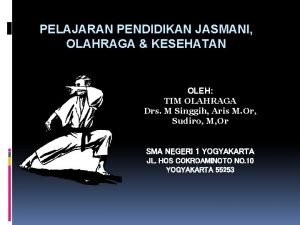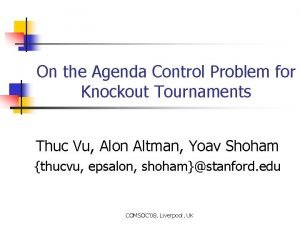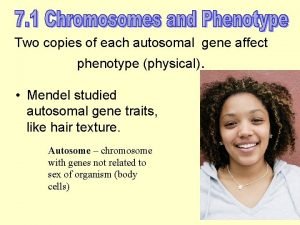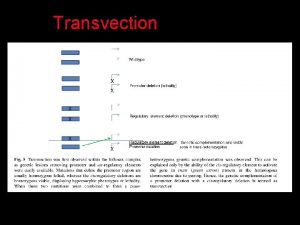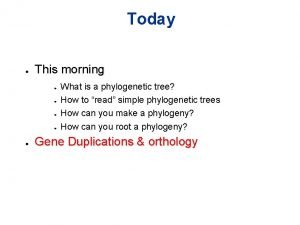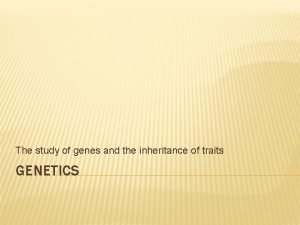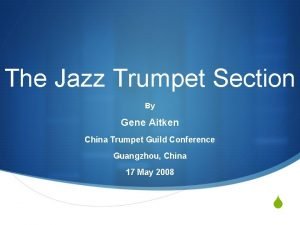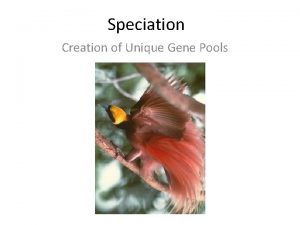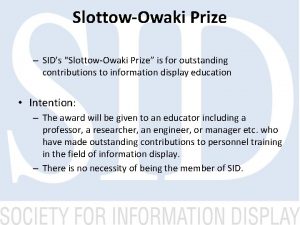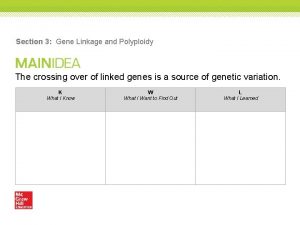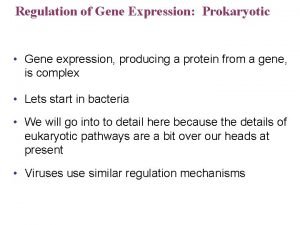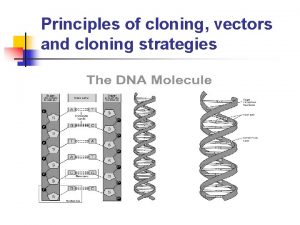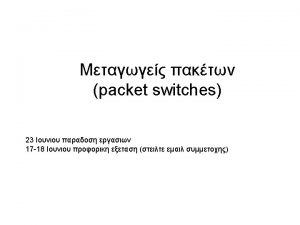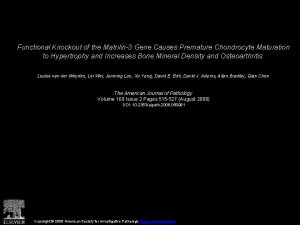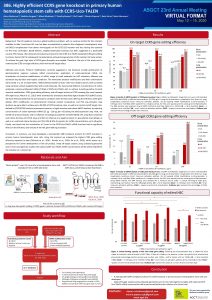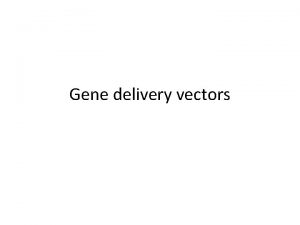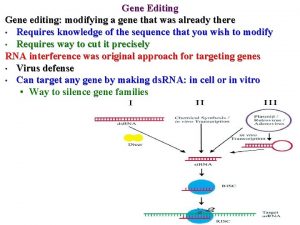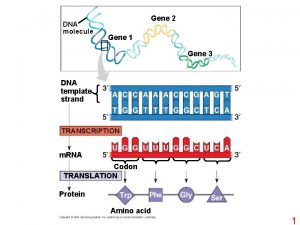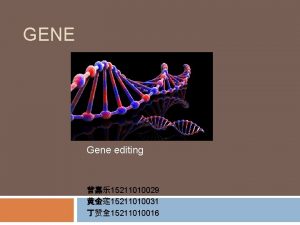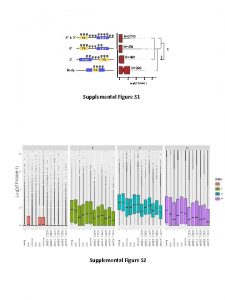GENE KNOCKOUT 1 INTRODUCTION A gene knockout is



























- Slides: 27

GENE KNOCKOUT 1

INTRODUCTION • A gene knockout is a genetically engineered organism that carries one or more genes in its chromosomes that have been made inoperative (have been "knocked out" of the organism) • The technology of gene knockout is based on gene targeting, a useful technique that utilizes homologous recombination to modify the genome of a living organism. • The term also refers to the process of creating such an organism, as in "knocking out" a gene. 2

INTRO. CONT’D • Knockouts are basically used to study the function of specific genes • R e v e rs e g e n eti c s is us e d to determine or g a ni s m a n d n o rm al o rg an sim. the knockout • Other forms of gene disruption • gene knockdown… reduce expression of the gene • knock-in… replace one allele (e. g. , wild type) with another (e. g. a specific mutation) 3

INTRO. CONT’D • A conditional knockout allows gene deletion in a tissue specific manner. • Simultaneously knocking out • 2 genes → double knock out • 3 genes → triple knockout • 4 genes → quadruple knockout 4

HISTORY • • Researcherswho de v eloped ht e et ch nool g yf or t h e c r e ati on o f k noc kout m ic e wo n N ob el P rzi e ni th e y ear 2007. The Nobel Prize in Physiology or Medicine 2007 was awarded jointly to Mario R. Capecchi, Sir Martin J. Evans and Oliver Smithies "for their discoveries of principles for introducing specific gene modifications in mice by the use of embryonic stem cells". Mario. R Capecchi gene knockout • Sir Martin J. Evans cultivation of ES cells • Oliver Smithies gene targeting 5

BASIC METHOD FOR GENE KNOCK OUT • Gene knockout is accomplished by a combination of techniques. Beginning from the test tube with plasmid, a bacterial artificial chromosome or other DNA construct, and then proceeding to cell culture. • Genetically, individual cells are transformed with a construct. ( knockout in multicellular organisms use Stem cell from nascent embryo). • C o n struct is engineered to recombine with the target ge n e. 6

METHOD CONT’D • With its sequence interrupted, the altered gene in most cases will be translated into a non – functional protein. • Recombination is a rare event → thereforeign sequence chosen for insertion usually is a reporter for easy selection of recombinants. 7

KNOCKOUT MOUSE • G en e to b il r a ry. be knocked out is isolated from mouse gene • Generation of targeting vector • contains pieces of DNA that are homologous to target gene, just inoperative. • positive and negative selection markers / cassettes ( SC) • neomycin phosphotransferase (neor) gene and HSV thymidine kinase (HSV-tk) gene respectively 8

KNOCKOUT MOUSE CONT’D Positive • flanked by two arms of homologous sequence • to enrich recombination events. • expression cassettes encoding antibiotic resistance genes. negative • outside one homologous arm • used to enrich for homologous recombination events over random insertions. • Use of Herpes Simplex Virus (HSV) Thymidine Kinase (TK) gene coupled with gancyclovir treatment 9

KNOCKOUT MOUSE CONT’D • Two homology arms flank a positive drug selection marker (neor). A negative selection marker (HSV-tk) is placed adjacent to one of the targeting arms. A unique restriction enzyme site is located between the vector backbone and the homology arm. When linearized for gene targeting, the vector backbone will then protect the HSV-tk from nucleases. Overview: Generation of Gene Knockout Mice, Bradford Hall 1, Advait Limaye 1, and Ashok B Kulkarni 1, 1 Curr Protoc Cell Biol. 2009 September ; CHAPTER: Unit– 19. 1217. doi: 10. 1002/0471143030. cb 1912 s 44. 10

EMBRYONIC STEM( ES) CELL ISOLATION • Embryonic stem (ES) cells are undifferentiated cells isolated from the inner cell mass of a blastocyst (Evans and Kaufman, 1981). • Are pluripotent • Most importantly the three germ layers – ectoderm, endoderm and mesoderm. • Replicate indefinitely. 11

ES CELL TRANSFECTION • St em c e lsc o m b in ed with the ele c rtop oraito n a n d cu u tl red. new sequence through • random integration occurs • hom o log o u s recom bi na tio no cc u rs of ne w g e ne o t r epal c e odl o n e. → incorporation • The antibiotic genes will aid in selection of mutants. • Discrete colonies are identified and picked for screening of positive clones. • PCR • Southern blotting and DNA sequencing. 12

RECOMBINATION Homologous recombination Random integration 13

REGENERATION • Positive stem cells are incorporated into the blastocyst cells of another mouse. • The blastocysts contain two types of stem (chimera): the orign i al ones (grey mouse), newly engineered ones (white mouse) • Thes e b las toc ysts a r e t he n im p la nte d i n to the of ef m a e l m ci e , t o co mp l e e t h t e p r e gna n cy. cells and the uterus • The newborn mice will therefore be chimeras: parts of t h eirbo d ies re s ult f rom th e or ig in al ste mc ells, other p a rts r e sutl fr o m h t e eng n i ee re d s tem c el s. 14

REGENERATION CONT’D • Their furs will show patches of white and grey • New-born mice are only useful if the newly engineered sequence was incorporated into the germ cells (egg or sperm cells) 15

OVERALL PROCESS 16

• A chimeric mouse gene targeted for the agouti coat color gene, with its offspring 17

APPLICATIONS OF GENE KNOCKOUT • Allows the test of specific functions of particular genes and to observe the processes that these particular genes could regulate. • Enables us to monitor the effects a particular gene. • Biomedical research-understanding how a certain gene contributes to a particular disease, researchers can then take the knowledge a step further and look for drugs that act on that gene. E. g. obesity, heart 18

• May lead to the discovery of the next generation of therapies for curing numerous diseases based on novel targets from the human genome. 19

CONCERNS • Many knockout mice die while they are still embryos before the researcher has a chance to use the model for experimentation. • There is mostly increased cost in caring for genetically altered organism • Some religious organizations have objections to the use of embryonic stem cells. Many other groups disagree with their use as well 20

CONCERNS CONT’D • The gene may serve a different function in adults than in developing embryo • Knocking out a gene also may fail to produce an observable change in a mouse or may even produce different characteristics from those observed in humans in which the same gene is inactivated. E. g. mutations in the p 53 gene associated with cancers and tumours. 21

GENE KNOCKOUT IN PLANTS • Use of gene targeting in plants has proven very difficult. • No efficient methods of gene knockout have yet been developed for use in plants. • Insufficient frequency or efficiency of homologous recombination. • This is overcome by any of these ways 22

GENE KNOCKOUT IN PLANTS CONT’D • Gene targeting with transposons and bacterial recombination systems. • These consist of recognition sequences and an enzyme( Transposase or recombinase) that cut DNA segments out of the genome and reintegrate at the recognition sequences and reintegrate them at another site 23

GENE KNOCKOUT IN PLANTS CONT’D • Gene targeting through stimulation of the cell’s own recombination processes. • In this method, a special DNA-cutting enzyme (“I-Sce. I” restriction enzyme) is used to cut the DNA strand at two sites in the plant genome. It is then possible at these sites to carry out recombination processes and so to achieve a targeted exchange of homologous sequence segments. 24

REFERENCES • The Nobel Prize in Physiology or Medicine 2007514551 http: //www. genome. gov/12^ nature news, 19 May 2003. • Y Zan et al. , Production of knockout rats using ENU mutagenesis and a yeast-based screening assay, Nat. Biotechnol. (2003). • Alani, E. , L. Cao, & N. Kleckner (1987). A method for gene disruption that allows repeated use of URA 3 selection in the construction of multiply disrupted yeast strains. Genetics 116: 541 -545. • a b genome. gov | Background on Mouse as a Model 25

REFERENCES CONT’D • Evans, M. J. & Kaufman, M. H. Establishment in culture of pluripotential cells from mouse embryos. Nature 292, 154– 156 (1981) 26

THANKS FOR YOUR AUDIENCE 27
 Menyebutkan angka patokan dalam sistem gugur
Menyebutkan angka patokan dalam sistem gugur Belgian knockout
Belgian knockout Challenge tournament advantages and disadvantages
Challenge tournament advantages and disadvantages Knockout pot design
Knockout pot design Boxing knockout
Boxing knockout Knockout
Knockout Knockout mouse project
Knockout mouse project Knockout drum vs scrubber
Knockout drum vs scrubber Gene by gene test results
Gene by gene test results Chapter 17 from gene to protein
Chapter 17 from gene to protein Body paragraph
Body paragraph Gene woodard
Gene woodard Two copies of each autosomal gene affect
Two copies of each autosomal gene affect Hox gene mutation in drosophila
Hox gene mutation in drosophila Species tree
Species tree Are brown eyes dominant over green
Are brown eyes dominant over green Sfzp music
Sfzp music Tay
Tay Hox gene mutation in drosophila
Hox gene mutation in drosophila H. gene slottow
H. gene slottow X linked gene punnett square
X linked gene punnett square Section 4 gene regulation and mutations
Section 4 gene regulation and mutations Section 3 gene linkage and polyploidy
Section 3 gene linkage and polyploidy Lac operon in prokaryotes
Lac operon in prokaryotes Gene regulation
Gene regulation Cosmid vector slideshare
Cosmid vector slideshare Allelic frequencies
Allelic frequencies Pike freshman center
Pike freshman center
